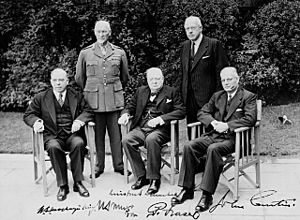1944 Commonwealth Prime Ministers' Conference facts for kids
Quick facts for kids 1st Commonwealth Prime Ministers' Conference |
|
|---|---|
 |
|
| Host country | |
| Dates | 1 May 1944– 16 May 1944 |
| Cities | London |
| Heads of Government | 6 |
| Chair | Winston Churchill (Prime Minister of the United Kingdom) |
| Follows | 1937 Imperial Conference |
| Precedes | 1946 |
| Key points | |
|
Supporting the Moscow Declaration
Coordination of war effort |
|
The 1944 Commonwealth Prime Ministers' Conference was a very important meeting. It was the first time that the leaders, also known as Heads of Government, from different countries of the British Commonwealth came together.
This special meeting happened in the United Kingdom from May 1st to May 16th, 1944. The host of the conference was Winston Churchill, who was the Prime Minister at that time. The main goal was to discuss how to work together during World War II.
Contents
What Was the 1944 Commonwealth Conference About?
This conference brought together leaders from many countries that were part of the Commonwealth. The Commonwealth is a group of nations that used to be connected to the British Empire. They often work together on shared goals.
Who Attended the Conference?
The Prime Ministers from most of the self-governing countries, called Dominions, in the Commonwealth were there. These included:
- John Curtin, the Prime Minister of Australia
- William Lyon Mackenzie King, the Prime Minister of Canada
- Peter Fraser, the Prime Minister of New Zealand
- Jan Smuts, the Prime Minister of South Africa
Also present was Sir Godfrey Huggins, the Prime Minister of Southern Rhodesia. This was a self-governing colony at the time. The Maharaja of Jammu and Kashmir represented India.
Important members of Winston Churchill's War Cabinet also joined the discussions. High Commissioners, who are like ambassadors, from the Dominions were there too.
Why Didn't Ireland Participate?
Ireland, even though it was still considered a member of the British Commonwealth, did not take part. Ireland had not joined any similar conferences since 1932.
What Did the Leaders Decide?
The leaders of the British Commonwealth agreed to support the Moscow Declaration. This was an important agreement made earlier by the main Allied powers.
They also planned their roles in the overall war effort. This meant deciding how each country would help fight in World War II.
What Was the Scottish Independence Request?
Before the conference, two Scottish politicians, Robert McIntyre and Douglas Young, tried to get the leaders to discuss Scottish independence. They asked the Prime Ministers to invite Scotland to future Commonwealth meetings.
Most leaders saw this as an internal matter for the British government. Canada's Prime Minister, William Lyon Mackenzie King, was more open to the idea.
Key People at the Conference
Many important officials attended the conference to help with the discussions and decisions.
Ministers and Leaders
Military Leaders
Top military leaders also attended to discuss war strategies.
| Service Branch | Title | Name |
|---|---|---|
| Army | Chief of the Imperial General Staff | Field Marshal Sir Alan Brooke |
| Navy | First Sea Lord | Admiral of the Fleet Sir Andrew Cunningham |
| RAF (Air Force) | Chief of the Air Staff | Marshal of the Royal Air Force Sir Charles Portal |
Other important military figures included:
- General Sir Thomas Blamey from Australia
- Lieutenant-general Sir Hastings Ismay from the UK
- Lieutenant-general Edward Puttick from New Zealand
Diplomats and Civil Servants
Key government advisors and diplomats were also present.
- Sir Frederick Shedden, Secretary of the Department of Defence for Australia
- Norman Robertson from Canada
- Sir John Stephenson from the UK
- Sir Richard Hopkins, Permanent Secretary to the Treasury for the UK
See also

